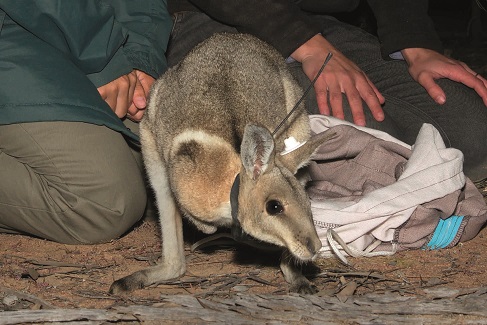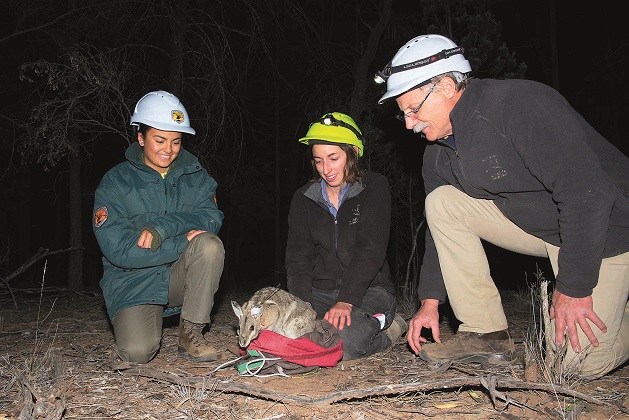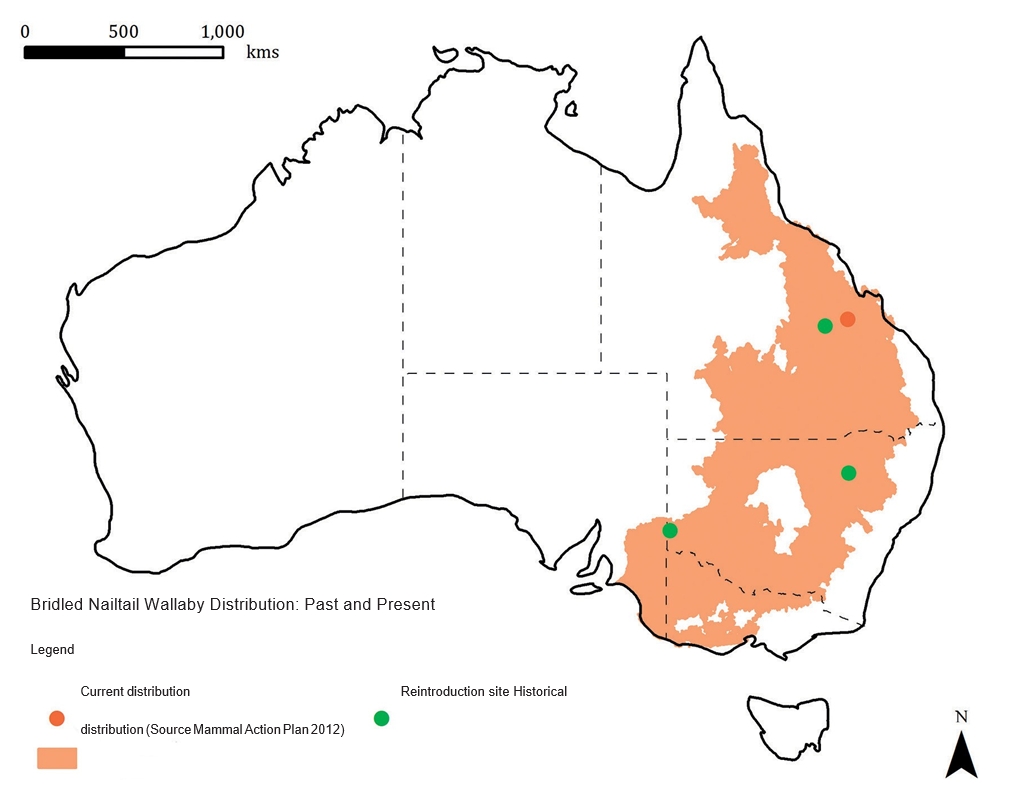By Dr Greg Holland, Senior Wildlife Ecologist
Australian Wildlife Conservancy, in partnership with the New South Wales Government, has achieved yet another remarkable outcome for the conservation of Australia’s threatened wildlife – the return of the Bridled Nailtail Wallaby (Onychogalea fraenata) to a conservation reserve on public land in NSW. The wallabies were reintroduced to the Pilliga State Conservation Area in September 2019. This is a major milestone in the historic partnership between AWC and the NSW Government, with two of six reintroductions earmarked for the Pilliga now complete. The first was the Greater Bilby (Macrotis lagotis) in late 2018. The Bridled Nailtail Wallaby was last recorded in the wild in NSW in the 1920s, and was thought to be completely extinct until rediscovered at a site in central Queensland in 1973.
 © Wayne Lawler/AWC
© Wayne Lawler/AWC
At the Pilliga project area, Bridled Nailtail Wallabies were released into a secure, 680 hectare, feral predator-free area specially created by AWC for the reintroductions of threatened mammals. The wallabies will be released into the larger, 5,800 hectare fenced area once it has been declared feral predator-free. Predation by introduced cats and foxes is the primary cause of the extinction of small to medium-sized mammals in the Pilliga forest (and elsewhere across Australia), with reintroductions only possible to areas where feral predators are excluded.
AWC ecologists translocated 42 adult wallabies (22 males, 20 females) to the Pilliga. Eleven of the females were carrying pouch young. The animals came from two sources: the last remaining remnant population at Taunton National Park in Queensland (25 adults and eight pouch young) and AWC’s Scotia Wildlife Sanctuary, in south-west NSW (17 adults and three pouch young). Securing animals from Taunton National Park involved a collaboration between the NSW and Queensland governments, the Bridled Nailtail Recovery Group and AWC. The availability of animals from Scotia highlights the importance of AWC’s secure, fenced populations of threatened species in providing animals for reintroductions to NSW National Parks and elsewhere.
 © Wayne Lawler/AWC
© Wayne Lawler/AWC
A detailed genetic management plan for the Bridled Nailtail Wallaby informed the Pilliga reintroduction, including the optimal source of animals, and ratio of males to females. This will enhance the rate of growth of the new Pilliga population and maximise its genetic diversity and adaptive potential. In time, this population is expected to grow to more than 2,000 individuals, and will in turn provide an important source of animals for future reintroductions of this species.
The translocation process
At Taunton, AWC ecologists worked with staff from Queensland’s Department of Environment and Science, who provided local knowledge and experience. A team of AWC ecologists conducted all work at Scotia. Expert veterinary teams provided advice and conducted health examinations.
Young adults, weighing between 2.0 and 4.5 kilograms, were targeted for translocation to maximise both longevity and reproductive output once released at the Pilliga. A uniquely coded microchip was implanted into each wallaby to enable permanent individual identification. Each animal was also fitted with a numbered ear tag and a VHF radio transmitter attached via a collar. Ear tags allow individual identification from remote camera images, while radio collars permit the survival of animals to be determined in the months following release.
Wallabies selected for translocation were flown by charter flight to Narrabri, then loaded into transport vans and driven to the Pilliga. Shortly after nightfall and a final health check, the Bridled Nailtail Wallabies were released at pre-determined locations inside the feral predator-free area. Most animals took a cautious approach to exploring their new home, taking the time to sniff the air and scan their surroundings before hopping away.
The new Bridled Nailtail Wallaby population in the Pilliga will be carefully monitored. VHF radio collars will provide information on their survival for up to 12 months post-release. An automated data-logging system, similar to that being implemented by AWC at Newhaven Wildlife Sanctuary and at Mallee Cliffs National Park, is ensuring signals are recorded for each individual on most days. Remote cameras will provide information on animal activity and habitat preferences. Finally, trapping of the population will occur every three months in the first year post-release. This will provide valuable information on animal health and condition, and allow the size of the population to be estimated.
Securing the future of the Bridled Nailtail Wallaby
The Bridled Nailtail Wallaby was once continuously distributed throughout inland areas of eastern Australia (west of the Dividing Range). Prior to this reintroduction, the Bridled Nailtail Wallaby was found in just three locations:
1. The remnant population at Taunton National Park;
2. A small reintroduced population at Avocet Nature Refuge (near Taunton National Park); and
3. The reintroduced population at AWC’s Scotia Wildlife Sanctuary.
Establishment of this new population in the Pilliga is, therefore, of critical importance to the conservation and long-term persistence of the species. The Pilliga population increases the number of secure populations of the Bridled Nailtail Wallaby, while also increasing total population size. It also restores the wallaby to part of its former range, ensuring the long-term adaptive potential of the species is maintained.

Restoring natural ecological processes
AWC is working in partnership with the NSW National Parks and Wildlife Service as part of its Saving our Species program to reintroduce a further four regionally extinct mammals to the Pilliga State Conservation Area: Brush-tailed Bettong (Bettongia penicillata), Plains Mouse (Pseudomys australis), Western Barred Bandicoot (Perameles bougainville) and Western Quoll (Dasyurus geoffroii). In addition to the significant conservation benefits for each individual species, restoration of much of the former small mammal assemblage will also reinstate important ecological processes including herbivory, predation, seed/spore dispersal and soil engineering (e.g., burrows, foraging pits). The reintroduction program is expected to have far-reaching ecological benefits.
Funding for the construction of the Pilliga fence, feral eradication, land management and species reintroduction has been provided by the NSW State Government as part of its $41.3 million Reintroduction of Locally Extinct Mammals Project (implemented across three NSW parks) and part of the Saving our Species program. In addition to the Pilliga, AWC is partnering with the NSW Government to reintroduce regionally-extinct mammals into a feral predator-free area at Mallee Cliffs National Park. Importantly, AWC is also responsible for measuring broader ecological health and delivering land management services at both locations. As the only non-government conservation organisation contracted to manage part of the public land estate, AWC is leading the way in this bold new approach to conservation in Australia.